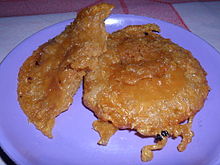


Brown kue cucur acquired from brown palm sugar
| |
| Alternative names | Kuih cucur (Malaysia), khanom fak bua or khanom chuchun (Thailand) |
|---|---|
| Course | Dessert |
| Place of origin | Indonesia |
| Region or state | Jakarta and Nationwide in Indonesia, also popular in Malaysia, Thailand and Singapore |
| Serving temperature | hot, warm, or room temperature |
| Main ingredients | Rice flour, sugar, coconut milk |
Kue cucur (Indonesian) or kuih cucur (Malay), known in Thaiaskhanom fak bua (ขนมฝักบัว, pronounced [kʰā.nǒm fàk būa̯]) or khanom chuchun (ขนมจู้จุนorจูจุ่น), is a traditional snack from Indonesia, and popular in parts of Southeast Asia, includes Indonesia, Malaysia, southern Thailand and Singapore. In Indonesia, kue cucur can be found throughout traditional marketplaces in the country; the popular version, however, is the Betawi version from Jakarta.[1]InBrunei and Malaysia, the term cucur is generally used to refer to any type of fritters. A popular type of cucur in Brunei and Malaysia is Jemput-jemput (also known as Cokodok) and Pinjaram (also known as Kuih cucur gula merah/melaka). In Southern Thailand, it is often featured in wedding ceremonies and festivals.
The dessert, made of fried rice flour mixed with palm sugar, is thick in the middle and thin at the edges. Thai people believe that it is similar to the lotus which can grow in poor conditions. Thus, it is like the love of a newly married couple that will smoothly grow up and succeed in married life. Thai people like to use it at a wedding or propitious ceremony, or at any festival. Sometimes it is given as a gift. Normally, Thai people like to eat it immediately after it is fried because it is still soft and colorful, and smells good. If it is left for an hour, it will be sticky, stiff and full of oil.
|
| |||||||||||||
|---|---|---|---|---|---|---|---|---|---|---|---|---|---|
| Common dishes |
| ||||||||||||
| Snacks |
| ||||||||||||
| Desserts |
| ||||||||||||
| Drinks |
| ||||||||||||
| Condiments |
| ||||||||||||
| |||||||||||||
|
| |
|---|---|
| Individual dishes |
|
| Shared dishes |
|
| Isan dishes |
|
| Northern Thai dishes |
|
| Southern Thai dishes |
|
| Snacks |
|
| Desserts |
|
| Miscellaneous |
|
| Beverages |
|
| See also |
|
| |
|
| ||
|---|---|---|
| Wet (basah) |
| |
| Dry (kering) |
| |